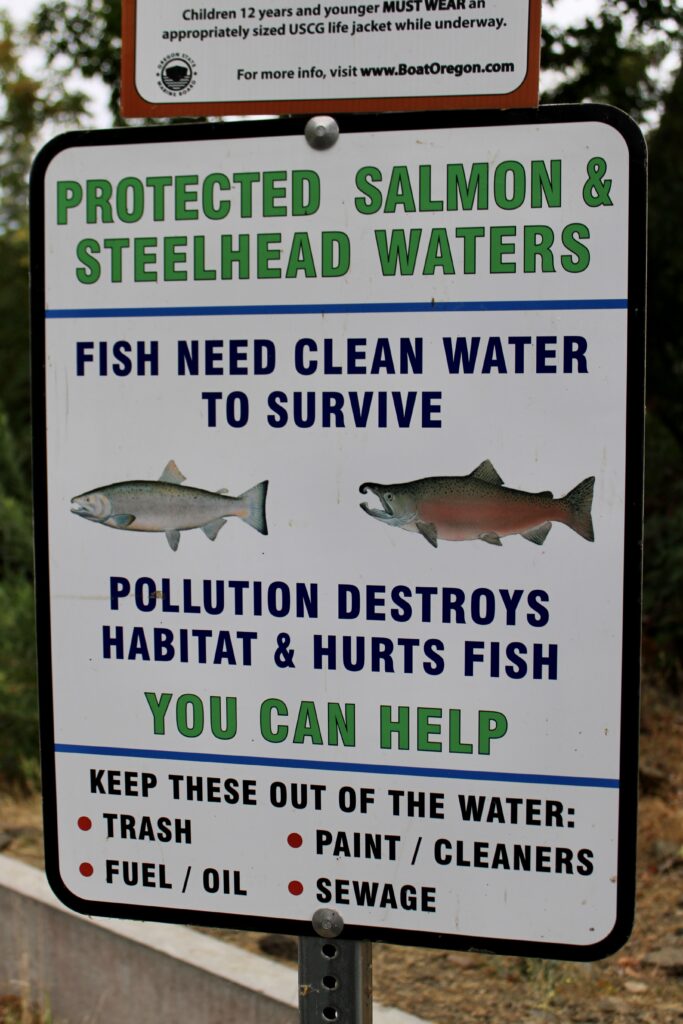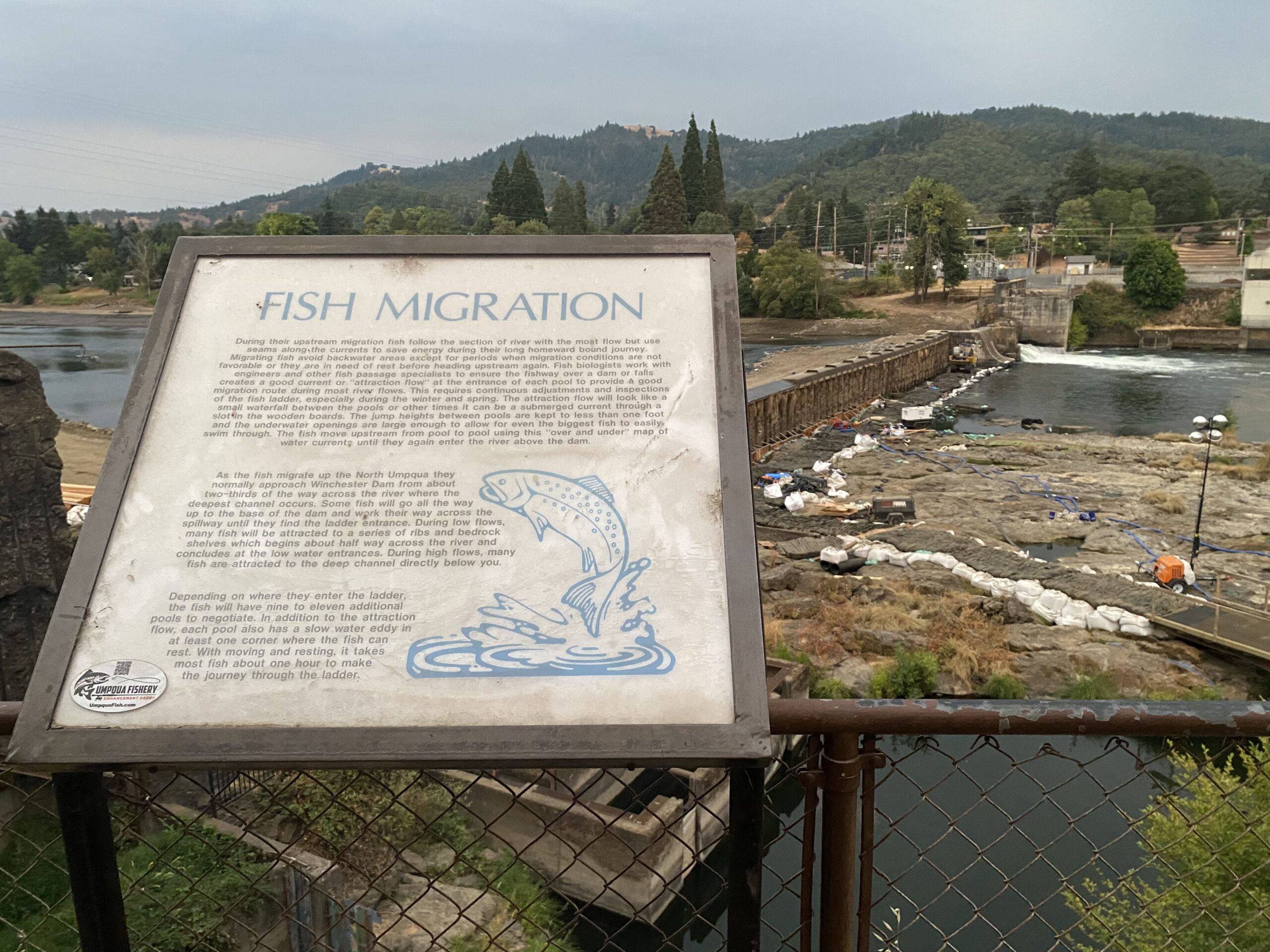Ask ODFW Commission to Hold Winchester Water Control District Accountable
Taunting “Fish Migration” and “Fish Passage” with glamorous portraits of jumping salmon and steelhead and the value of southwest Oregon’s native fish species, the interpretive signage above the Winchester Dam, which sits just upstream of where I-5 passes over the North Umpqua river, is nothing short of ghastly.
On one of the more prominent signs, placed directly beside the pedestrian pathway to the observation point, the spaces where either artist’s renditions or potentially carved models of Chinook salmon, coho salmon, steelhead trout, Pacific lamprey and more, are now completely empty.
Nothing but pale, sun bleached wood where the fish should be placed, for everyone to enjoy and engage with.
Below is the dam, bustling with heavy construction noises. From inside the fish ladder viewing area, one can only see mud through the heavily streaked glass.
All this, only weeks after one of the most famed rivers in steelheading was completely closed to recreational fishing.
Again.
Like the signs, the fish are missing in the river, and all I can think about is how hot it is.
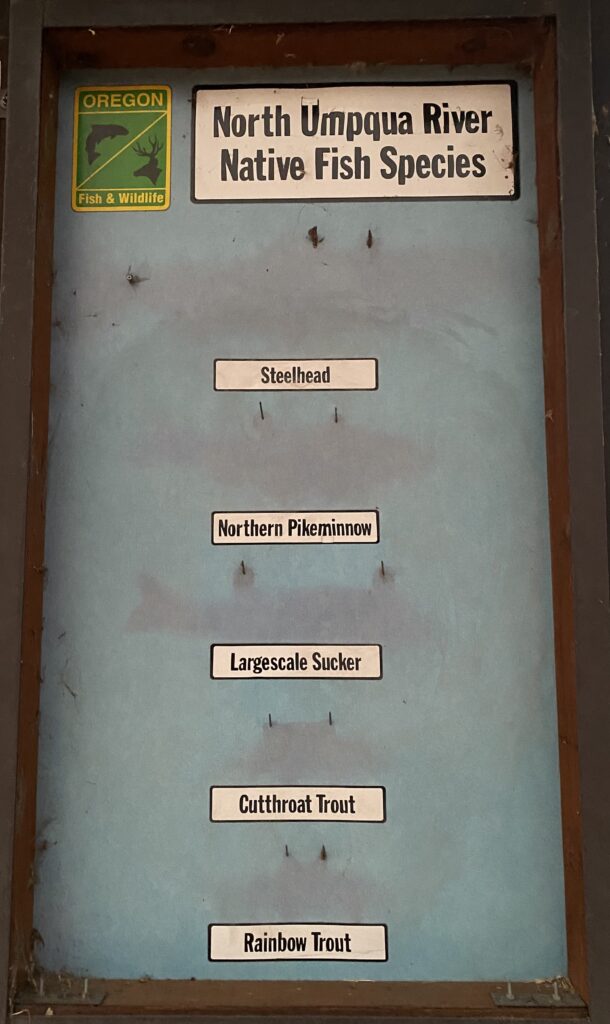
Ask ODFW Commission to Hold Winchester Water Control District Accountable
How Did We Get Here?
Below the upper stretches of the North Umpqua River near the town of Roseburg sits Winchester dam. Sitting 118 miles upriver from the Pacific Ocean, the 133-year-old timber crib dam is primarily designed for water collection and hydropower. Hydropower was removed from the dam in the 1980s and the City of Roseburg’s water intake was moved downstream. Ownership of the dam changed to the Winchester Water Control District (WWCD) — wealthy homeowners that live on the reservoir pool above the dam. Its main purpose? Providing private recreation to a few hundred homeowners living above the dam.
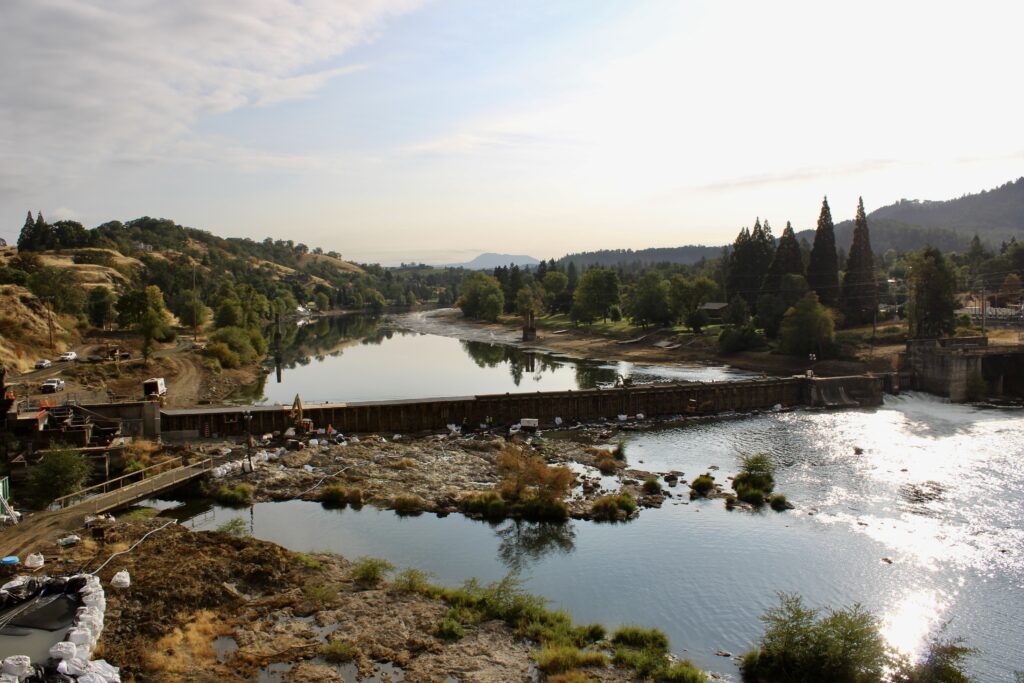
A private waterski lake on a public waterway causing delay, harm, and death to salmon, steelhead and lamprey, that depend on the river’s moving water.
The major “why” the Winchester Dam is one of the largest fish-killing dams in the Pacific Northwest surrounds the fish ladder, ladder placement and the complete neglect to upkeep and maintain the dam. The ladder was built in the early 1940s to provide fish passage and has had little to no updates. Since then, there has been no substantial maintenance, no ladder updates to better pass salmon and steelhead. Removing this neglected dam would open 160 miles of prime spawning and rearing habitat for fish to thrive.
To top it all off, despite a confusing design that is outdated and dilapidated, the ladder sits in the wrong spot to provide uninterrupted fish passage. It sits on the shallowest portion of the river. Fish traveling upstream must move from the south side of the dam, banging their heads against the dam face to the north side of the dam before finally reaching the entrance to the fish ladder. While making this journey, fish encounter hundreds of false attraction holes (holes in the dam that look like a possible passage for fish.)
In 2018, the owners “repaired” Winchester Dam.
After obtaining emergency repair permits from regulators, WWCD poured green concrete into the river, killing hundreds of fish, The Oregon Department of Fish and Wildlife (ODFW) clearly documented these abuses. Conservation groups notified the Department of Environmental Quality (DEQ), who pressed charges.
Beginning on August 7th, 2023, WWCD began repairing false attraction holes, shutting off all fish passage for three weeks while these repairs occur during the tail end of peak summer steelhead migration. According to historic dam counts, 10 percent of the summer steelhead migration occurs during this time. However, repairs don’t require the owners to shut down fish ladder function, and engineers and project managers could have easily proposed building coffer dams (earthen dams that isolate the dam face) instead of dewatering the dam. They did not, however, on account of the cost. ODFW and NOAA Fisheries authorized these plans and is not requiring homeowners to build coffer dams.
Dewatering the dam has stranded fish migrating during this time, cooking them in the dangerously hot waters downstream.
In 2015 conservation groups managed and funded the removal of Gold Ray Dam on the famous Rogue River of southern Oregon. A project that was designed to overwhelmingly support restoring salmon and steelhead. When completing that project ODFW did not allow blocking fish passage for one minute.
A summer steelhead massacre is in the works, approved by approved by ODFW, who by accord of their own mission, is committed by state constitution to “protect and enhance Oregon’s fish and wildlife and their habitats for use and enjoyment by present and future generations.”
The plans to repair the dam will not solve the long term issues or problems with the dam or ladder. Plans will simply fill holes that have been created from decades of neglect by using polyurethane plastic foam.
Not to mention, the owners are pinching pennies to make repairs, putting harmful plastics in our rivers affecting drinking water and our fish. Instead of using plastic, owners could easily use cobble, as they have in prior repairs. Included in the plans for repair is fixing the hole on the south side of the dam that was attempted to be repaired in 2018 by pouring green concrete into the river. The repair in 2018 lasted less than four years.
“So, the question is not one of repairing the dam or not. The question is whether to repair the dam right or not. And what they chose is to repair the dam in a sloppy way that has the highest impact to the run. We thought that was inappropriate,” Jim McCarthy of Oregon WaterWatch told Oregon Public Broadcasting.
The Hits Keep Coming
The feeling is sickening, stepping off the banks of the North onto a raft with Kirk Blaine, Southernt Oregon Regional Coordinator for the Native Fish Society.
Blaine and I are rowing just downstream of Winchester Dam, in search of fish. Not in the usual way a steelheader might look for fish in August.
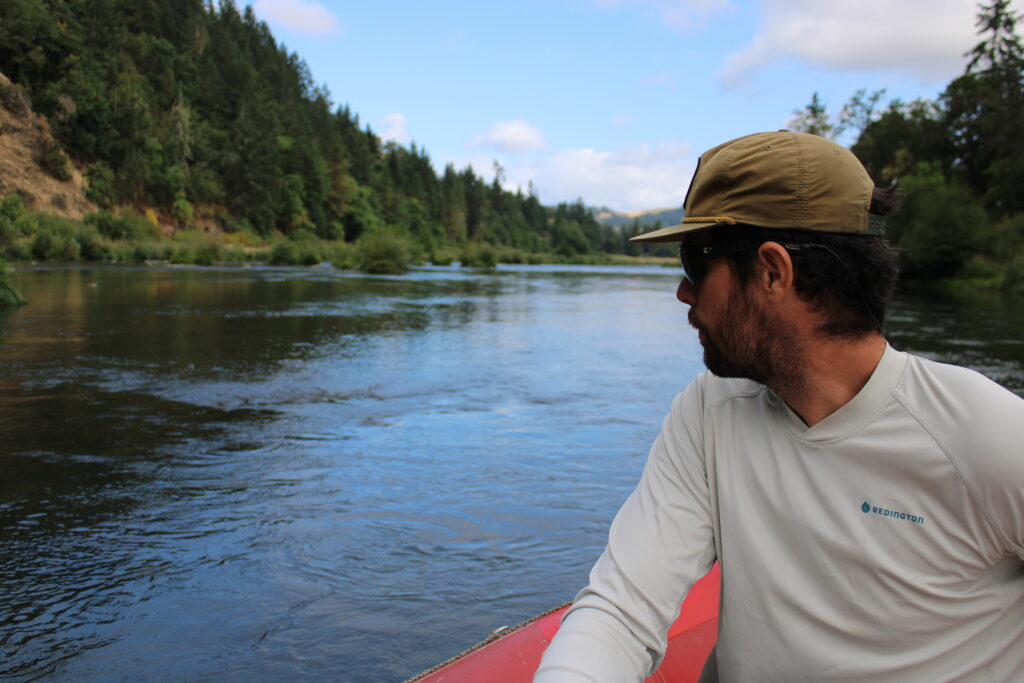
We were looking for dead fish, victim to downstream water contamination of their impassable holding pools.
On August 14th, Blaine first observed TerraFirma Foundation Systems gray water, contaminated by freshly poured concrete residue, seeping out of contained area into the North.
Blaine, from his perch above the construction, was seen watching and filming. After spotting Blaine documenting, TerraFirma workers changed their mode of operations. They then began pumping the water into a holding tank, before emptying filtered water into a swimming pool.
Little more than a week later, a little after 7 a.m. on Monday, August 21st, Blaine and other river advocates claim to have observed TerraFirma once again pumping water polluted with freshly poured concrete from their primary work area by the dam fence into a poorly constructed, inadequate holding pond. TerraFirma had not properly isolated their work area with the freshly poured concrete from the flowing river, so a continuous flow of polluted water was overflowing the holding pond and dumping water polluted with wet concrete directly into the North Umpqua.
Blaine, from his perch above the construction, was seen watching and filming. After spotting Blaine documenting, TerraFirma workers changed their mode of operations. They then began pumping the water into a tank, before emptying filtered water into a holding pool.
Shortly after seeing this, river advocates reported this violation to the Oregon DEQ, Oregon Department of state Lands, ODFW, U.S.Army Corp of Engineers, U.S. Fish and WIldlife Service (USFWS) and National Oceanic and Atmospheric Administration (NOAA) Fisheries.
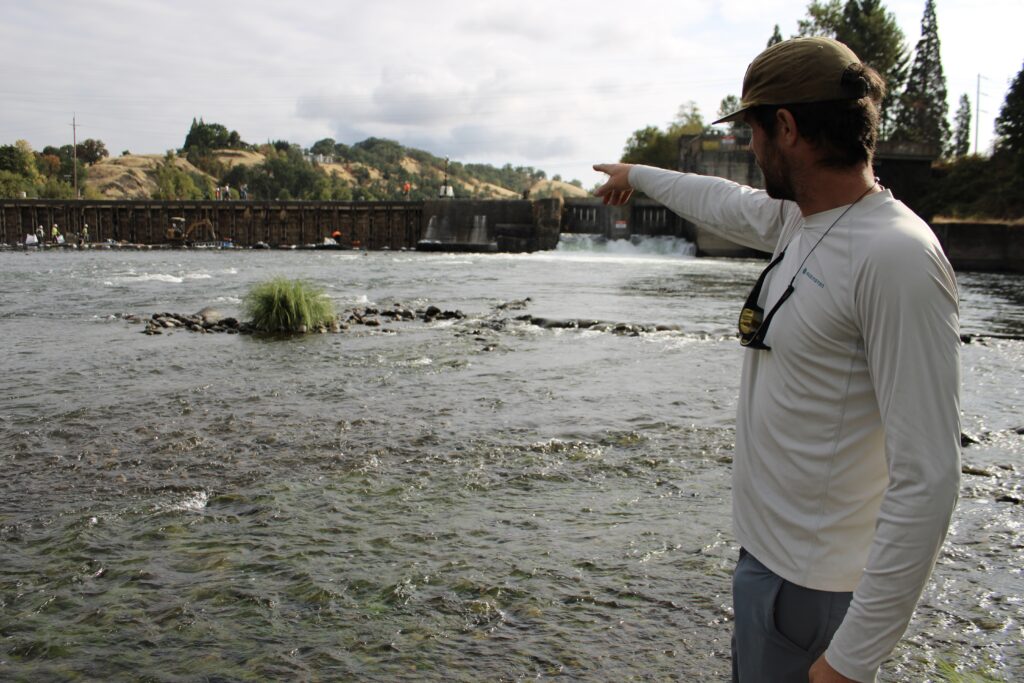
Blaine confirmed that that morning, no agencies were observed mobilizing to the spill site or otherwise reacting to their complaints.
Shockingly, yet again, on August 24th, TerraFirma was seen pumping water polluted by freshly poured concrete — which raises the PH levels of the North Umpqua’s water to levels causing mortality in salmonids — into a container, which was pumping into and overflowing that same holding pool.

Contaminants directly from concrete are, unfortunately, not the only reports of alleged permit violations underway and continuing at Winchester Dam.
For example, on the morning of August 11th, officials from state, federal, and tribal wildlife agencies combed vast stretches of drying reservoir sediments above Winchester Dam on the North Umpqua River in an effort to stem losses from a massive fish kill. Upwards of hundreds of thousands of young Pacific lamprey are feared lost due to reservoir dewatering.
This drawdown repair option was chosen by dam owners specifically for its cheapness compared with other common repair options, despite its known high impacts on the North Umpqua’s aquatic life, habitat, and drinking water supplies. State and federal officials chose to approve the owners’ repair proposal, despite having the authority to require lower-impact repair methods, despite repeated formal pleas from river advocates to avoid the anticipated mass mortality of aquatic life by requiring a lower-impact repair alternative, and despite a well-documented history of mass mortality of aquatic life during previous dam repairs using the same drawdown method.
Worth noting, when considering the record of decision making, is that Ryan Beckley, the president of the Winchester Water Control District is also the owner of TerraFirma Foundation Systems, the contractor repairing the dam. According to all available data at this time, TerraFirma Foundation Systems has no experience on any dam construction or renovation.
The death toll for the North Umpqua’s native aquatic life remains to be calculated, but it is expected to be staggering. According to public records, during a 2013 reservoir drawdown and a subsequent scramble by wildlife officials and the Cow Creek Band of Umpqua Tribe of Indians to rescue fish from the carelessness of the Winchester Dam owners, The Cow Creek Tribe “estimated conservatively that for every one live lamprey salvaged, there were approximately 10 dead in the same area (about 1ft2).” The dam repair plan calls for the approximately 7,500-foot-long reservoir to remain dewatered from August 7th until August 28th.
Since day one, heavy machinery has been observed operating in what can be formally defined as “open waters of the state.” Anyone who has ever worked a construction job knows just how likely a machine like that used at Winchester is capable of leaking hydraulic fluid, diesel fuel and more. These materials would have moved downstream byway of water passing through the busted dam, picking up the leaked materials and then flowing directly back into the mainstream flow.
The road that this construction equipment travels on in order to operate below the dam, is constructed on top of boulders which were place above the Winchester Dam, and passed over the top.
“There’s little reason to believe that those boulders are going anywhere,” Blaine explained. “Few people recognize the importance of that plunge pool area just below the dam face, where juvenile outmigrating salmonids can and adult kelt pass over the top of the dam, drop more than a dozen feet, and then historically have had a soft landing.
Now, that landing area is filled with vehicle-sized debris and rocks.
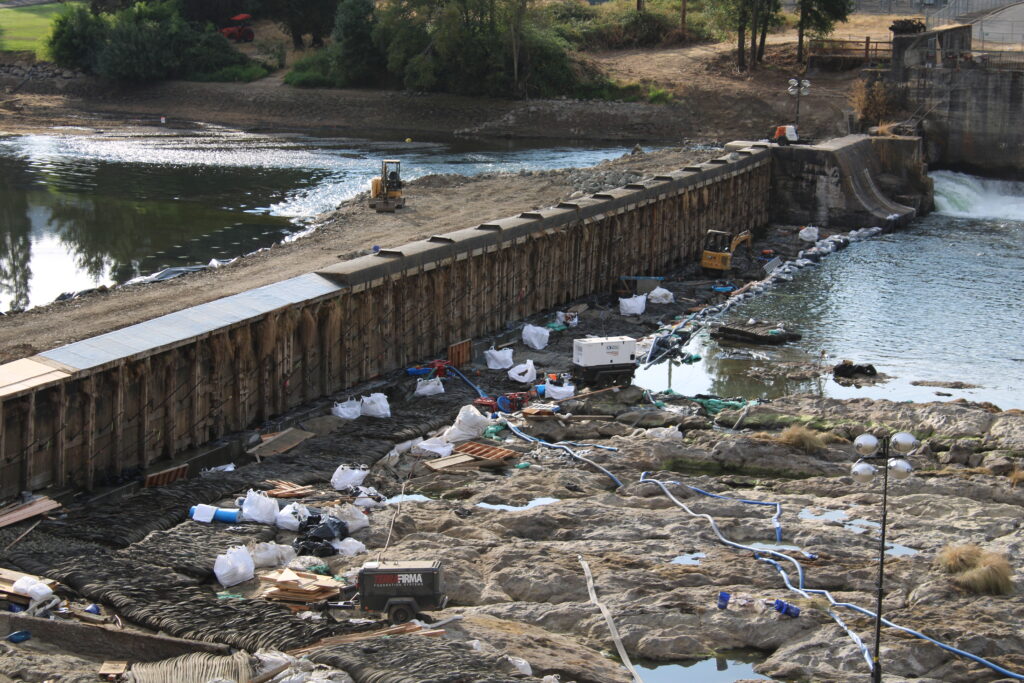
“A three week closure is unacceptable for the North Umpqua River,” Blaine told Swing The Fly on Aug. 24th. “It should have never occurred in the first place. I think even ODFW expected this to be a bit more organized. This is shocking.”
Only days later, WWCD applied for a week extension on construction. The project is still ongoing, two days after their extension — three weeks and three days of total fish passage blockage.
I look at the weather application on my iPhone. A break from the heat, but now it is raining, and summer steelhead will be moving east upriver.
Blaine reports summer steelhead, too few in numbers for even a fly fishing only catch and release fishery season, can be seen unsuccessfully attempting to jump the spillway.
Ask ODFW Commission to Hold Winchester Water Control District Accountable
Better Late Than Never
“This dam, this issue in general, is a huge legal and political issue, for everyone involved,” Blaine said. “It’s like we’re getting bigfooted. If you or I tried to get these permits, it would be damn near impossible. We’re sitting here and this species is going extinct before our eyes, they are closing down the fishery to recreational angling, and the homeowners won’t update passage to state standards. Based on this current situation, it is clear WWCD cannot responsibly own and maintain this dam. This dam must be removed for the future of the North Umpqua and the Wild Summer Steelhead that call it home.”
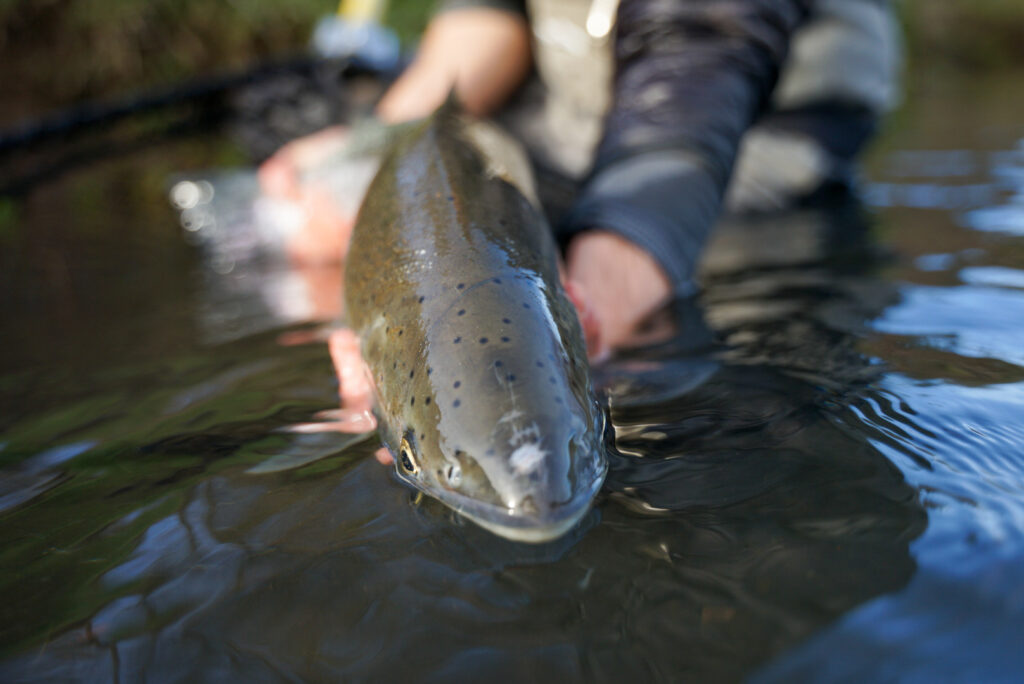
Rich Zellman, a longtime guide on the North Umpqua and board member of The Steamboaters, the nonprofit organization created to steward the North Umpqua, found the timing of the repairs particularly troublesome.
“Recreational anglers are shut out, because we didn’t have enough fish returning to the North. We supported that. It hurts my business, but it’s good for the river, for the long term. We all supported that choice. It was the right thing to do” Zellman shared. “But to close the river, and then allow this. This should have been held off, at the least.”
It appears ODFW, quiet until now, or worse yet, complacent, have opened their ears to anglers like Zellman. On Sept. 1st, ODFW sent a letter to Mr. Beckley and WWCD, where they clearly lay out how the Winchester Dam repair project is damaging native migratory fish (NMF) and that no additional permit extensions will be permitted once work is completed.
“Due to the construction not meeting the schedule, you are now in a situation where you are
negatively affecting NMF populations. Migration is being prevented and/or delayed as passage is
not sufficient through the spillway gates. From August 28, 2023 through today (September 1,
2023), ODFW staff have spent approximately 120 minutes observing fish attempting to migrate
through the spillway gates, and we have documented in excess of 100 passage attempts during that
time. We did not observe any fish successfully moving through the spillway gates. Videos you
provided on August 31, 2023 do not show clear evidence of successful fish passage through the
spillway gates,” ODFW said in it’s letter to Mr. Beckley. ” In addition to the lack of adequate fish passage, the delay and repeated burst swimming events will result in increased stress and energy expenditure, both of which are known to impact spawning success. Adult salmonids are currently wasting vital energy reserves and are becoming further stressed as they attempt to navigate the spillway. ODFW also believes there is high potential for physical injury as a result of high-speed contact with the concrete and spillway structures at the dam and the bedrock situated immediately below the spillway structure during passage attempts. Many of the spring Chinook currently delayed below the dam only have two weeks to migrate as far upstream as Soda Springs to spawn. The upstream migration of these fish is delayed as a direct result of your project not being completed on time. In addition, summer steelhead will be below
critical abundance again this year, a level below which ODFW has significant concerns about the
long-term viability of a population. ODFW has closed the North Umpqua River to recreation
angling and released previously collected hatchery broodstock in efforts to conserve the population. Your project delay is now negatively affecting this population.”
Although ODFW is taking this stance now, advocates claim this project as a whole has been negatively affecting NMF throughout it’s entirety. Especially since the applicant could have used alternative repair methods to fix this deadbeat dam that would have allowed uninterrupted fish passage.
On Sept. 14th and 15th, the ODFW Commission will hold a meeting in Bend, Oregon. Blaine, Zellman, The Steamboaters and NFS are encouraging all anglers with invested interest in the future of the North Umpqua fishery to show up or testify remotely by contributing a personalized statement to the commission asking them to enforce the penalties for any and all violations of permitted activity related to the repairs of Winchester Dam to the fullest extent possible.
Every angler and advocate for the health and wellbeing of the North Umpqua and its iconic steelhead will have an opportunity to lend their voice in support of an abundant, uninterrupted future for these fish. Beckley, WWCD and Terrafirma need to be held accountable for their damage to one of the steelhead communities No matter where you call home, if you have ever bought a license in Oregon, there is finally a moment for you to make tangible change, stand up for these fish and demand that justice could be served.
It might be the only dam way, to make this dam, go away.
“These fish need looking after,” Zellman told Swing The Fly. “More now, than ever.”
